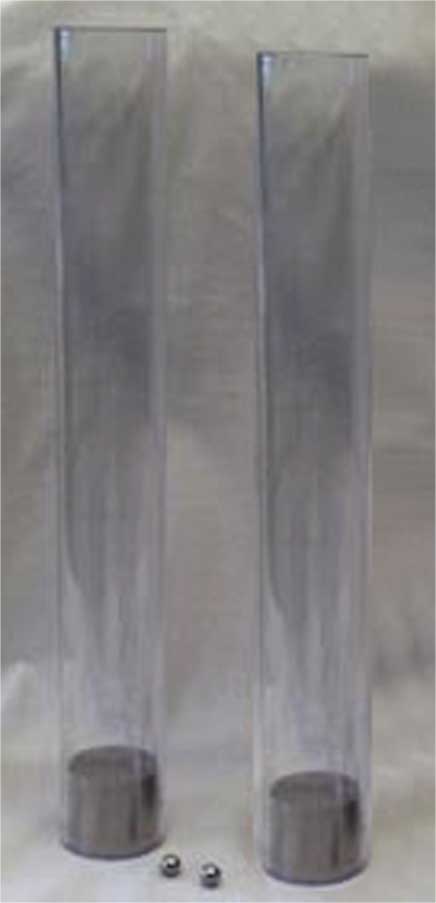 "Atomic Trampoline" Demonstrations with Amorphous Metal
"Atomic Trampoline" Demonstrations with Amorphous Metal
Here's a very neat amorphous metal demonstration kit which includes:
- a stainless steel base
- a stainless steel base with a 1/8 inch thick disk of Liquidmetal® (Zr41.2Be22.5Ti13.8Cu12.5Ni10.0) glued to it
- two clear plastic tubes which slide over the top of the bases
- two hardened steel ball bearings
- a booklet complete with pictures and figures which help explain the behavior of the amorphous metal, as well as some other activities to try with the demonstration set-up
Watch a movie of the Liquidmetal® demonstration.
The kit was formerly available through the Institute for Chemical Education (ICE) but further supplies are not expected to be available.
What is the science behind this unique demonstration?
For more information, see Glassy Metals in the April 2004 issue of Discover Magazine.
The ball bearing is being dropped from the same height, down identical plastic tubes, onto two different surfaces, one stainless steel, and one an amorphous metal called Liquidmetal®. Several ways in which the energy of the ball bouncing is dissipated are via sound, random collisions with the sides of the tubes, and friction with the air. Assuming that for both bases, these factors are, on average, the same, the difference in the ball bouncing must be due mainly to the difference in energy transfer between the ball and the two surfaces. The fact that the ball bounces for so much longer on the amorphous metal surface indicates a much different energy transfer interaction than that of the stainless steel base. In order to understand the different ball-surface interactions, we need to look more carefully at the structures of the two materials, stainless steel is a crystalline solid and Vitreloy is an amorphous metal.
Key to Understanding the Demonstration
Under the force of the ball impact, some of this energy is transferred to similar
planes of atoms which move past each other. In many cases this atomic motion results
in permanent deformation of the solid. The small pits on the surface
of the stainless steel base are evidence of how the ball bearing impacts have
deformed the surface.
|
|
|
| The small pits in the stainless steel base are evidence of the permanent (or plastic) deformation that ocurrs when the ball bearing is dropped onto the surface. This deformation is a high energy process, accounting for much of the energy dissipation of the bouncing ball. |
At 7.5x magnification, the pitting of the stainless steel base is clear. The three pits in this image are from consecutive bounces of the steel ball bearing on the surface of the base. |
We also tried this experiment with a really tall tube filled with either air or sulfur hexafluoride. Does the gas in the tube make a difference?
This amorphous alloy was developed by William Johnson at Caltech in 1992.
The Boston Museum of Science has adapted the "Atomic Trampoline" for a museum display.
Liquidmetal® alloys are products of Liquidmetal Technologies.
Executive Offices
100 North Tampa Street Suite 3150
Tampa, Fl 33606
Otis Buchanan, Vice President, Media Relations
813-314-0280 x109

